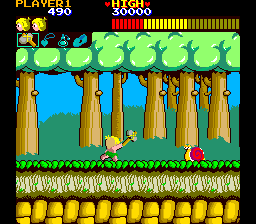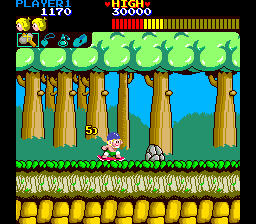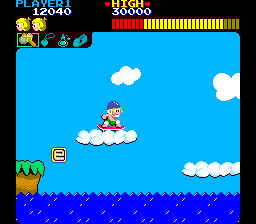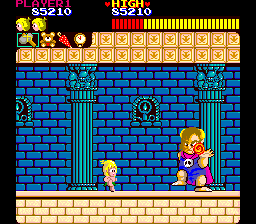Wonder Boy for Arcade
ArcadeGame controls in browser
Show Controller & SystemClick on play Arcade game now button first to load the game into the emulator. Before the start do not forget to toss the coin first (key 1) into the machine slot. Arcade controls:
Wonder Boy
Online version of Wonder Boy for Arcade. Wonder Boy (Wandā Bōi) is a 1986 platform game published by Sega and developed by Escape (now known as Westone Bit Entertainment). Originally designed for arcades, it was later ported to the SG-1000, Master System and Game Gear consoles by Sega, and to the ZX Spectrum, Commodore 64 and Amstrad CPC home computers by Activision. The titular Wonder Boy is a tribal caveman-like boy whose girlfriend Tina has been captured by the dark King. The player must guide the Wonder Boy through seven areas, each consisting of four rounds. The boy can arm himself with a stone hatchet, which he can throw at oncoming foes, a skateboard with which he can rush through the levels and temporary protection by an angel which allows him to destroy foes by simply running into them...
Game details
Other platforms online 4
You can play Wonder Boy online also in a versions for0%
rating (0 users voted)
Covers - Box Art
Arcade game
Online emulated version of Wonder Boy was originally developed as arcade game or coin-op game,
a coin-operated entertainment machine typically installed in public businesses such as restaurants, bars and amusement arcades. Most arcade games are video games,
pinball machines, electro-mechanical games, redemption games or merchandisers. While exact dates are debated, the golden age of arcade video games is usually defined
as a period beginning sometime in the late 1970s and ending sometime in the mid-1980s.
Virtually all modern arcade games (other than the very traditional Midway-type games at county fairs) make extensive use of solid state electronics,
integrated circuits and cathode-ray tube screens. In the past, coin-operated arcade video games generally used custom per-game hardware often with multiple CPUs,
highly specialized sound and graphics chips, and the latest in expensive computer graphics display technology. This allowed arcade system boards to produce
more complex graphics and sound than what was then possible on video game consoles or personal computers, which is no longer the case in the 2010s.
This emulation is powered by MAME (Multiple Arcade Machine Emulator) project, an open-source emulator designed to recreate the hardware of arcade game systems in software on modern personal computers and other platforms. Its intention is to preserve gaming history by preventing vintage games from being lost or forgotten.







